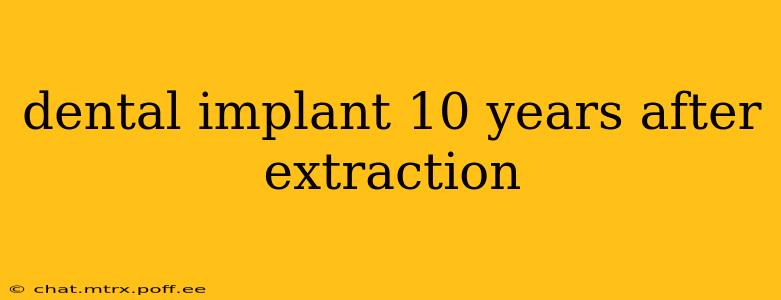Getting a dental implant ten years after an extraction is a common scenario, and it's entirely possible, though it might require a slightly different approach than a more recent extraction. This comprehensive guide explores the process, considerations, and potential challenges involved. We'll address common questions and concerns surrounding this procedure.
Is it Too Late for a Dental Implant 10 Years After Extraction?
No, it's not too late. While the ideal time for implant placement is often sooner after extraction, a successful implant placement is possible even a decade later. However, the procedure may involve additional steps to prepare the jawbone and ensure optimal integration. The success rate remains high, but careful evaluation and planning by an experienced periodontist or oral surgeon are crucial.
What Happens to the Jawbone After 10 Years?
Over time, after a tooth is extracted, the jawbone naturally resorbs, or shrinks. This bone loss is a natural process, and the degree of resorption varies depending on individual factors like bone density and overall health. Ten years post-extraction could result in significant bone loss in the area, potentially making implant placement more complex. This bone loss impacts the stability and longevity of the implant.
How Does Bone Loss Affect Implant Placement?
Insufficient bone mass can compromise implant stability. A stable bone foundation is critical for successful osseointegration – the process by which the implant fuses with the jawbone. If there isn't enough bone, the implant might not integrate properly, leading to failure.
What Procedures Might Be Necessary Before Implant Placement?
To address bone loss, several procedures may be necessary before implant placement:
-
Bone Grafting: This procedure involves adding bone material to the jawbone to increase its volume and density, creating a more suitable foundation for the implant. Various types of bone grafts exist, including autografts (from the patient's own body), allografts (from a donor), and synthetic grafts.
-
Guided Bone Regeneration (GBR): GBR techniques aim to stimulate bone growth in specific areas, often used in conjunction with bone grafting. Membranes are used to guide the bone regeneration process, protecting the area from soft tissue invasion.
-
Sinus Lift: If the implant is planned in the upper jaw's posterior region, a sinus lift might be required. This procedure lifts the sinus membrane to create space for bone grafting, adding bone volume in areas where the sinus cavity encroaches on the jawbone.
How Long Does the Entire Process Take?
The timeline for getting a dental implant 10 years after extraction is longer than for a recent extraction. It involves several stages:
- Initial Consultation and Assessment: Includes a thorough examination, X-rays, and possibly CT scans to evaluate bone density and overall oral health.
- Preparatory Procedures (if needed): Bone grafting, sinus lift, etc., require healing time, typically several months.
- Implant Placement: A minor surgical procedure to place the implant fixture in the jawbone.
- Osseointegration: The healing period allowing the implant to fuse with the jawbone (several months).
- Abutment Placement: Connecting the implant to the crown.
- Crown Placement: The final artificial tooth is attached.
The entire process can take 6 months to a year or more, depending on the individual's needs and the complexity of the procedures involved.
What Are the Costs Involved?
The cost of dental implants 10 years after extraction is generally higher than a more straightforward case due to the potential need for bone grafting and other preparatory procedures. The total cost varies significantly based on the individual's specific situation, the number of implants needed, the location of the practice, and the materials used. It is best to consult with your dentist or oral surgeon for a personalized cost estimate.
What Are the Long-Term Success Rates?
With proper planning and execution, the long-term success rates of dental implants remain high, even 10 years after extraction. Careful attention to oral hygiene and regular dental check-ups are crucial for maintaining the implant's longevity.
Can I Get a Dental Implant 10 Years After Extraction if I Have Gum Disease?
Gum disease (periodontitis) can significantly affect the success of dental implants. It's crucial to address and treat any gum disease before implant placement. Untreated gum disease increases the risk of infection and implant failure. Your dentist will likely recommend periodontal treatment before proceeding with the implant procedure.
This guide provides general information. It is essential to consult with a qualified periodontist or oral surgeon for a personalized assessment and treatment plan. They can evaluate your specific situation, recommend the most appropriate procedures, and address any concerns you may have. Remember, individual outcomes may vary.
